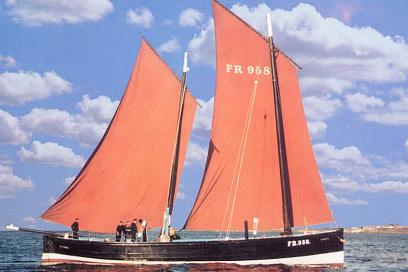Over the past few weeks, I've been busy writing about other topics and had left my workshop somewhat forgotten, so after cleaning and sharpening blades, I reviewed my plans and cut wood, and here I started a Russian sailboat. I'll begin with its origins and characteristics.
REYUSHA ASTRAKHAN
1 History
The boat we'll be discussing was the "kosovye" boat, whose origins date back to the time of Stepan Razin (1630-1670). In Bogoslavsky's book "On Merchant Shipbuilding in Russia, Rivers, and Coasts," the seaworthiness of a "kosovye" vessel is described as follows.
"With a cutwater inclined 30° from the vertical and a bow raised more than a foot above the deck, the vessel, so to speak, effortlessly rises over the approaching waves. These, when cut by the cutwater, pass calmly without throwing a single drop onto the deck, sliding down the sides of the hull." The first "rechniki" (or "small kosovye boats," as they were then called) appeared in the early 19th century. The name "rechnik" probably comes from the local word "reit" (to tack). The length of these vessels ranged from 8 to 10 m (up to 18 m in some cases), the beam from 1.8 to 2.8 m, and the draft from 0.6 to 1.0 m.”
“The general characteristics of this boat are that the forecastle (from the cutwater to the bulkhead in frame 5) had a shelter where fishermen could rest and seek protection from bad weather. The first compartment (between frames 5 and 9) was used to store nets and tackle. The second compartment (between frames 9 and 10) was for storing fish; the last housed fishing tools and supplies. The open, unobstructed stern was used for working with the nets, preparing food, and other tasks.”
“The boat had a carrying capacity of approximately 7 tons. Regarding the rigging, they carried a quartersail. Later, a fixed mast with a quartersail was adopted. The total sail area was 50–60 m². This simple design allowed for high speed, maneuverability in narrow rivers, and the ability to sail upwind.”

REYUSHA ASTRAKHAN
1 History
The boat we'll be discussing was the "kosovye" boat, whose origins date back to the time of Stepan Razin (1630-1670). In Bogoslavsky's book "On Merchant Shipbuilding in Russia, Rivers, and Coasts," the seaworthiness of a "kosovye" vessel is described as follows.
"With a cutwater inclined 30° from the vertical and a bow raised more than a foot above the deck, the vessel, so to speak, effortlessly rises over the approaching waves. These, when cut by the cutwater, pass calmly without throwing a single drop onto the deck, sliding down the sides of the hull." The first "rechniki" (or "small kosovye boats," as they were then called) appeared in the early 19th century. The name "rechnik" probably comes from the local word "reit" (to tack). The length of these vessels ranged from 8 to 10 m (up to 18 m in some cases), the beam from 1.8 to 2.8 m, and the draft from 0.6 to 1.0 m.”
“The general characteristics of this boat are that the forecastle (from the cutwater to the bulkhead in frame 5) had a shelter where fishermen could rest and seek protection from bad weather. The first compartment (between frames 5 and 9) was used to store nets and tackle. The second compartment (between frames 9 and 10) was for storing fish; the last housed fishing tools and supplies. The open, unobstructed stern was used for working with the nets, preparing food, and other tasks.”
“The boat had a carrying capacity of approximately 7 tons. Regarding the rigging, they carried a quartersail. Later, a fixed mast with a quartersail was adopted. The total sail area was 50–60 m². This simple design allowed for high speed, maneuverability in narrow rivers, and the ability to sail upwind.”

Last edited:






































